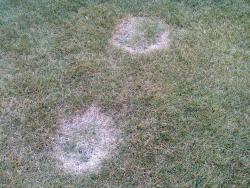
Most turf grass diseases occur due to environmental conditions; the lawn is too wet, too dry, mowed to short or a combination. Most turf diseases will grow out with fertilization and adjustments to the water and mow schedule.
Ascochyta Leaf Blight is a common problem on Kentucky bluegrass lawns in Colorado.
- Large uniform areas of affected turf will turn straw-colored.
- Blades usually start dying back from the tips.
- Ascochyta can occur throughout the growing season, but is more prevalent in the spring when there are extended wet periods.
- May occur on drought-stressed turf caused by watering restrictions and poor irrigation system coverage.
- Ascochyta survives on dead leaves or clippings remaining in the thatch and can be spread by splashing rain, irrigation, mowing or other management activities.
The first line of defense against leaf blight is to manage the turf properly.
Read more at http://www.ext.colostate.edu/pubs/garden/02901.html
Necrotic Ring Spot (NRS) appears in the spring in local Kentucky bluegrass lawns.

This disease results in “frogeye” patches of live grass within a ring of dead grass. This is a disease that lives in the soil and not the turf plant itself. There is currently no “cure” for NRS; but certain turf management practices to reduce the appearance of the unsightly rings.
Fertilize moderately at a low rate; a mix of slow and quick release nitrogen is recommended.
- Aerate at least once a year.
- Avoid over-watering.
- Mow at 2 ½” to 3”.
Over-seeding infected lawns with certain bluegrass varieties that show some resistance to NRS can also be helpful.
Fungicides applications may help suppress the disease.
Lawn Dr. of Ft. Collins recommends the Steady Growth Program to meet fertilization recommendations and two fungicide treatments when soil temperatures are optimal to treat NRS. Call us at 970.221.0441 for more information and pricing
You can read more about NRS at http://www.ext.colostate.edu/ptlk/1528.html
a. Most turf grass diseases occur due to environmental conditions; the lawn is too wet, too dry, mowed to short or a combination. Most turf diseases will grow out with fertilization and adjustments to the water and mow schedule.
Ascochyta Leaf Blight is a common problem on Kentucky bluegrass lawns in Colorado.
· Large uniform areas of affected turf will turn straw-colored.
· Blades usually start dying back from the tips.
· Ascochyta can occur throughout the growing season, but is more prevalent in the spring when there are extended wet periods.
· May occur on drought-stressed turf caused by watering restrictions and poor irrigation system coverage.
· Ascochyta survives on dead leaves or clippings remaining in the thatch and can be spread by splashing rain, irrigation, mowing or other management activities.
The first line of defense against leaf blight is to manage the turf properly.
Read more at http://www.ext.colostate.edu/pubs/garden/02901.html
2. Necrotic Ring Spot (NRS) appears in the spring in local Kentucky bluegrass lawns. This disease results in “frogeye” patches of live grass within a ring of dead grass.
a. This is a disease that lives in the soil and not the turf plant itself.
b. There is currently no “cure” for NRS; but certain turf management practices to reduce the appearance of the unsightly rings.
i. Fertilize moderately at a low rate; a mix of slow and quick release nitrogen is recommended.
ii. Aerate at least once a year.
iii. Avoid over-watering
iv. Mow at 2 ½” to 3”.
c. Over-seeding infected lawns with certain bluegrass varieties that show some resistance to NRS can also be helpful.
d. Fungicides applications may help suppress the disease.
Lawn Dr. of Ft. Collins recommends the Steady Growth Program to meet fertilization recommendations and two fungicide treatments when soil temperatures are optimal to treat NRS. Call us at 970.221.0441 for more information and pricing
You can read more about NRS at http://www.ext.colostate.edu/ptlk/1528.html
